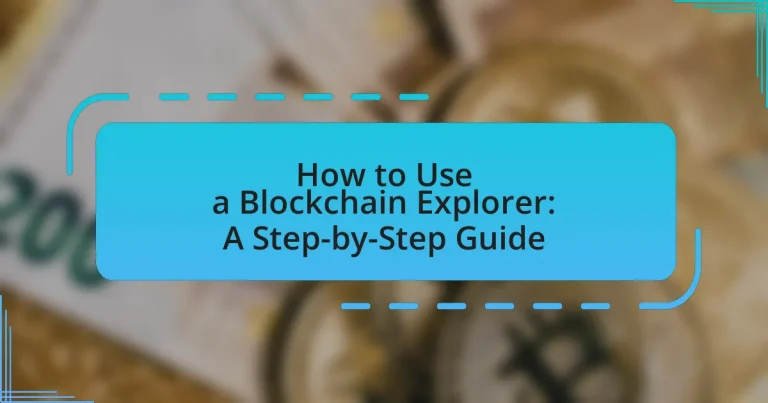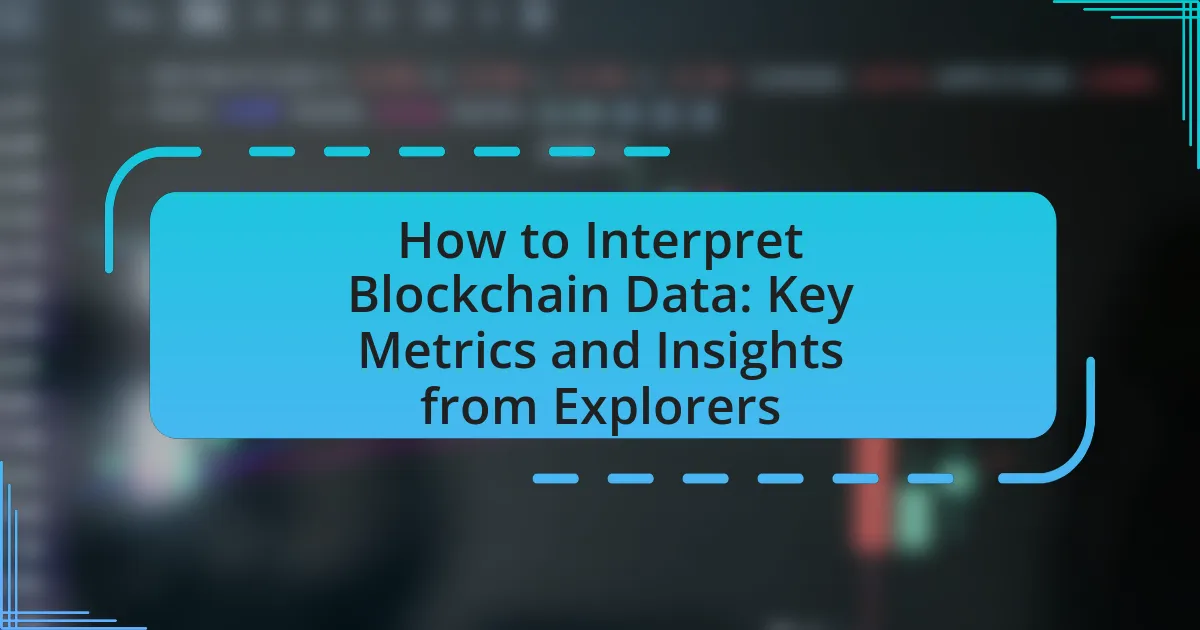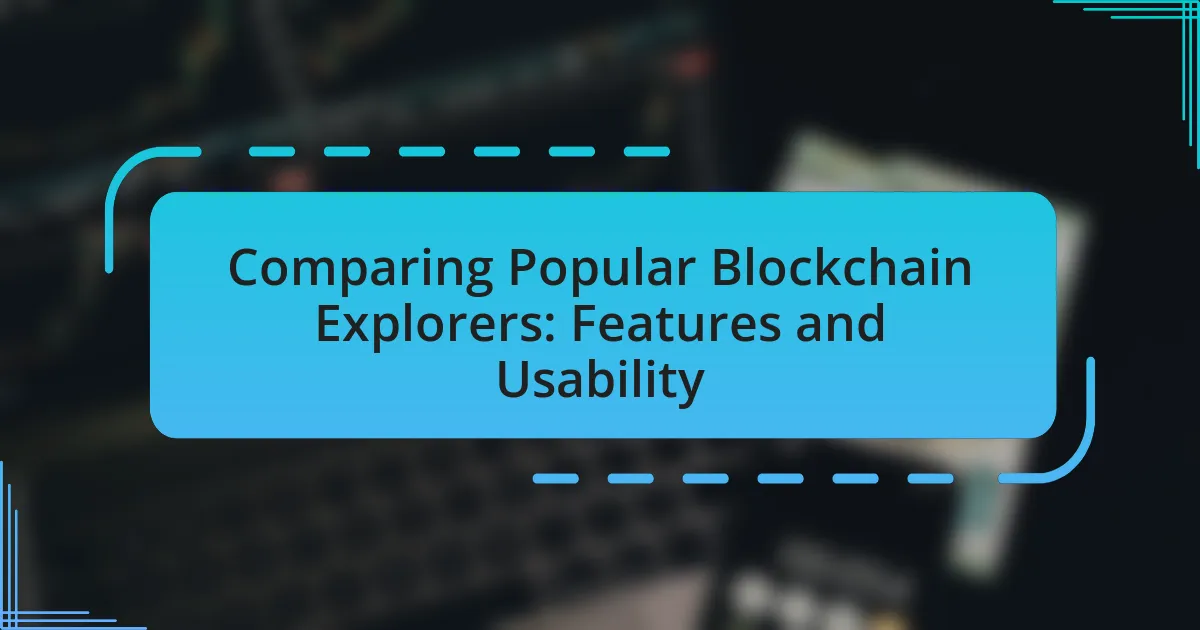A blockchain explorer is a web-based tool that enables users to view and search blockchain data, including transaction histories, block information, and wallet addresses. This article provides a comprehensive guide on how to effectively use a blockchain explorer, detailing its functionalities, key features, and the importance of transparency in blockchain transactions. It covers how to access different types of explorers, search for specific transactions, and track wallet addresses, while also highlighting best practices for ensuring accuracy and avoiding common mistakes. Additionally, the article discusses the role of blockchain explorers in enhancing user trust and understanding of blockchain activity.
What is a Blockchain Explorer?
A blockchain explorer is a web-based tool that allows users to view and search the contents of a blockchain. It provides access to transaction data, block information, and wallet addresses, enabling users to track the movement of cryptocurrencies and verify transactions. For example, popular blockchain explorers like Etherscan for Ethereum and Blockchain.com for Bitcoin offer detailed insights into transaction history, block confirmations, and network statistics, making it easier for users to understand blockchain activity.
How does a Blockchain Explorer function?
A Blockchain Explorer functions by providing a user interface to access and navigate the blockchain’s data. It allows users to search for specific transactions, addresses, and blocks, displaying detailed information such as transaction IDs, timestamps, and amounts involved. Blockchain Explorers operate by querying the blockchain’s public ledger, which is a decentralized database that records all transactions in a transparent and immutable manner. This functionality is essential for verifying transactions and ensuring the integrity of the blockchain, as users can independently confirm the status and details of any transaction recorded on the network.
What are the key features of a Blockchain Explorer?
A Blockchain Explorer provides several key features that facilitate the exploration of blockchain data. These features include transaction tracking, which allows users to view details of specific transactions by entering transaction IDs; block information, enabling users to access data about individual blocks, including block height, timestamp, and miner; and wallet address lookup, which lets users check the balance and transaction history associated with a specific wallet address. Additionally, Blockchain Explorers often offer real-time network statistics, such as hash rate and transaction volume, and support for multiple cryptocurrencies, enhancing their usability across different blockchain networks. These features collectively empower users to gain insights into blockchain activity and verify transactions efficiently.
How does a Blockchain Explorer interact with blockchain networks?
A Blockchain Explorer interacts with blockchain networks by querying the blockchain’s public ledger to retrieve and display transaction data, block information, and wallet addresses. This interaction occurs through APIs that connect the explorer to the blockchain nodes, allowing it to access real-time data. For example, when a user searches for a specific transaction ID, the explorer sends a request to the blockchain network, which then returns the relevant details, such as transaction status, timestamps, and involved addresses. This functionality is essential for transparency and verification within blockchain ecosystems, as it enables users to track and confirm transactions independently.
Why is a Blockchain Explorer important?
A Blockchain Explorer is important because it provides transparency and accessibility to blockchain data. By allowing users to view transaction histories, block details, and wallet balances, it enhances trust in the blockchain ecosystem. For instance, Bitcoin’s blockchain explorer enables users to verify transactions in real-time, ensuring that the information is accurate and publicly available. This transparency is crucial for maintaining the integrity of decentralized networks, as it allows anyone to audit and confirm the legitimacy of transactions without relying on a central authority.
What role does it play in blockchain transparency?
Blockchain technology plays a crucial role in ensuring transparency by providing a decentralized and immutable ledger of transactions. This transparency allows all participants in the network to verify and audit transactions independently, reducing the risk of fraud and manipulation. Each transaction is recorded in a block and linked to previous blocks, creating a chronological chain that is accessible to anyone with permission to view it. This open access to transaction history is supported by cryptographic techniques that secure the data, making it nearly impossible to alter past records without consensus from the network.
How does it enhance user trust in blockchain transactions?
Blockchain enhances user trust in transactions through its inherent transparency and immutability. Each transaction is recorded on a public ledger that is accessible to all participants, allowing users to verify the authenticity of transactions independently. This transparency reduces the likelihood of fraud, as any attempt to alter transaction data would require consensus from the majority of the network, making it nearly impossible. Additionally, the cryptographic techniques used in blockchain ensure that data integrity is maintained, further reinforcing user confidence in the system.
How to Access a Blockchain Explorer?
To access a blockchain explorer, simply open a web browser and enter the URL of a specific blockchain explorer website, such as blockchain.com for Bitcoin or etherscan.io for Ethereum. Blockchain explorers are online tools that allow users to view and search blockchain data, including transaction history and wallet addresses. These platforms provide real-time information about the blockchain, enabling users to track transactions and verify their status.
What are the different types of Blockchain Explorers available?
There are several types of blockchain explorers available, including general-purpose explorers, specific blockchain explorers, and API-based explorers. General-purpose explorers, such as Blockchain.com and Blockchair, allow users to search across multiple blockchains. Specific blockchain explorers, like Etherscan for Ethereum and Blockstream.info for Bitcoin, focus on a single blockchain, providing detailed transaction and block information. API-based explorers, such as Infura, offer programmatic access to blockchain data, enabling developers to integrate blockchain functionalities into their applications. Each type serves distinct user needs, from casual browsing to advanced development.
How do public and private Blockchain Explorers differ?
Public and private blockchain explorers differ primarily in their accessibility and the type of data they provide. Public blockchain explorers, such as Etherscan or Blockchain.com, allow anyone to view transaction data, block information, and wallet addresses on open networks like Bitcoin or Ethereum, promoting transparency. In contrast, private blockchain explorers are designed for permissioned networks, restricting access to authorized users and often providing additional features tailored to specific organizational needs, such as enhanced privacy controls and customized data reporting. This distinction highlights the fundamental difference in user access and data visibility between public and private blockchain environments.
Which Blockchain Explorers are most popular for specific cryptocurrencies?
Etherscan is the most popular blockchain explorer for Ethereum, while Blockchain.com serves as a leading explorer for Bitcoin. For Bitcoin Cash, the most utilized explorer is Blockchair, and for Litecoin, the primary explorer is BlockCypher. These explorers are widely recognized due to their user-friendly interfaces and comprehensive data, including transaction history, block details, and wallet information, making them essential tools for users of these specific cryptocurrencies.
How can you choose the right Blockchain Explorer for your needs?
To choose the right Blockchain Explorer for your needs, assess the specific features and functionalities that align with your requirements. Different explorers offer varying capabilities such as transaction tracking, block information, and support for multiple cryptocurrencies. For instance, if you need to analyze Bitcoin transactions, a dedicated Bitcoin explorer like Blockchair may be more suitable, while Ethereum users might prefer Etherscan for its comprehensive smart contract data. Additionally, consider the user interface and ease of navigation, as a more intuitive design can enhance your experience. Security features, such as data encryption and privacy policies, are also crucial to ensure safe usage.
What factors should you consider when selecting a Blockchain Explorer?
When selecting a Blockchain Explorer, consider factors such as supported blockchains, user interface, transaction search capabilities, and additional features like analytics and charts. Supported blockchains determine the explorer’s versatility; for example, some explorers only support Bitcoin, while others cover multiple cryptocurrencies. A user-friendly interface enhances navigation and usability, making it easier to find information. Transaction search capabilities are crucial for tracking specific transactions or addresses efficiently. Additional features, such as real-time data, historical charts, and network statistics, provide deeper insights into blockchain activity, enhancing the overall user experience.
How do user interfaces impact the usability of a Blockchain Explorer?
User interfaces significantly impact the usability of a Blockchain Explorer by determining how easily users can navigate, access information, and perform transactions. A well-designed interface enhances user experience through intuitive layouts, clear labeling, and responsive design, which facilitate quick comprehension of complex blockchain data. For instance, studies show that users are 50% more likely to successfully complete tasks on platforms with user-friendly interfaces, highlighting the importance of usability in retaining users and ensuring effective interaction with blockchain technology.
How to Use a Blockchain Explorer Effectively?
To use a blockchain explorer effectively, start by entering the specific transaction ID, wallet address, or block number into the search bar. This action allows you to access detailed information about the transaction, including its status, confirmation count, and associated fees. Blockchain explorers provide real-time data, enabling users to track the movement of assets and verify transactions on the blockchain. For instance, platforms like Etherscan and Blockchair offer comprehensive insights into Ethereum and Bitcoin transactions, respectively, showcasing their utility in monitoring blockchain activity.
What are the basic functionalities of a Blockchain Explorer?
A Blockchain Explorer provides essential functionalities for users to interact with blockchain data. These functionalities include viewing transaction details, tracking wallet addresses, checking block information, and analyzing network statistics. For instance, users can input a transaction ID to retrieve specific transaction data, such as the amount transferred and the involved addresses. Additionally, users can search for wallet addresses to see their transaction history and current balance. Block information can be accessed to view details like block height, timestamp, and miner information. Lastly, network statistics provide insights into metrics such as transaction volume and network hash rate, which are crucial for understanding blockchain performance.
How can you search for a specific transaction using a Blockchain Explorer?
To search for a specific transaction using a Blockchain Explorer, enter the transaction ID or hash into the search bar of the explorer. This ID is a unique string that identifies the transaction on the blockchain. Once you input the transaction ID, the explorer will display detailed information about the transaction, including its status, the amount transferred, the sender and receiver addresses, and the block in which it was included. Blockchain Explorers, such as Etherscan for Ethereum or Blockchain.com for Bitcoin, provide this functionality, allowing users to verify and track transactions in real-time.
What information can you extract from a transaction hash?
A transaction hash provides essential information about a specific transaction on a blockchain. From a transaction hash, one can extract details such as the transaction’s status (confirmed or pending), the amount of cryptocurrency transferred, the sender’s and receiver’s wallet addresses, transaction fees, and timestamps indicating when the transaction was initiated and confirmed. Additionally, it may reveal any associated data, such as smart contract interactions or input/output details, depending on the blockchain’s structure. This information is verifiable through blockchain explorers, which allow users to track and validate transactions in real-time.
How can you track wallet addresses using a Blockchain Explorer?
You can track wallet addresses using a Blockchain Explorer by entering the specific wallet address into the search bar of the explorer. This action allows you to view all transactions associated with that wallet, including incoming and outgoing transfers, transaction amounts, and timestamps. Blockchain Explorers, such as Etherscan for Ethereum or Blockchain.com for Bitcoin, provide detailed transaction histories and balances, enabling users to analyze the activity of any public wallet address on the blockchain.
What details can you find about a wallet address?
A wallet address can provide several details, including transaction history, balance, and associated metadata. Transaction history reveals all incoming and outgoing transactions linked to the address, showing amounts, timestamps, and transaction IDs. The balance indicates the total cryptocurrency held at that address at any given time. Additionally, metadata may include tags or labels that users or services assign to the address, which can help identify its purpose or ownership. These details can be accessed through blockchain explorers, which aggregate and display this information in a user-friendly format.
How does transaction history help in understanding wallet activity?
Transaction history is essential for understanding wallet activity as it provides a detailed record of all transactions associated with a specific wallet. This record allows users to analyze patterns in spending and receiving funds, identify the frequency and volume of transactions, and assess the overall financial behavior of the wallet. For instance, by examining transaction timestamps and amounts, users can determine peak activity periods and recognize any unusual or suspicious transactions, which is crucial for security and financial management.
What advanced features can enhance your experience with a Blockchain Explorer?
Advanced features that can enhance your experience with a Blockchain Explorer include real-time transaction tracking, advanced search filters, and wallet address monitoring. Real-time transaction tracking allows users to see transactions as they occur on the blockchain, providing immediate insights into network activity. Advanced search filters enable users to narrow down results by parameters such as transaction type, date, or amount, making it easier to find specific information. Wallet address monitoring notifies users of any transactions involving their addresses, ensuring they stay updated on their holdings and activities. These features collectively improve usability and provide deeper insights into blockchain data.
How can you use filters to refine your search results?
You can use filters to refine your search results by applying specific criteria such as date range, transaction type, or address. These filters allow users to narrow down the vast amount of data available in a blockchain explorer, making it easier to find relevant transactions or blocks. For instance, filtering by date can help locate transactions within a specific timeframe, while filtering by transaction type can differentiate between standard transactions and smart contract interactions. This targeted approach enhances the efficiency of searches, ensuring users retrieve only the most pertinent information.
What insights can you gain from analyzing block data?
Analyzing block data provides insights into transaction patterns, network activity, and user behavior within a blockchain. By examining block data, one can identify trends such as peak transaction times, the volume of transactions over specific periods, and the distribution of transaction sizes. For instance, data from the Bitcoin blockchain shows that transaction volume tends to increase during market volatility, indicating heightened user activity. Additionally, analyzing the addresses involved in transactions can reveal the concentration of wealth and the movement of assets, which is crucial for understanding market dynamics.
What are some best practices for using a Blockchain Explorer?
To effectively use a Blockchain Explorer, users should follow best practices such as verifying transaction details, utilizing advanced search features, and ensuring the accuracy of addresses. Verifying transaction details helps confirm the status and authenticity of transactions, while advanced search features allow users to filter results by block number, transaction ID, or address, enhancing the efficiency of their searches. Ensuring the accuracy of addresses is crucial, as even minor errors can lead to incorrect information retrieval. These practices enhance the overall user experience and ensure reliable data access in blockchain networks.
How can you ensure accuracy when interpreting data from a Blockchain Explorer?
To ensure accuracy when interpreting data from a Blockchain Explorer, cross-reference the information with multiple reliable sources. This method validates the data by comparing transaction details, block confirmations, and wallet addresses against other blockchain explorers or official blockchain documentation. For instance, discrepancies in transaction amounts or timestamps can be identified by checking the same transaction on different explorers, such as Blockchair or Etherscan, which provide consistent data across platforms. This practice minimizes the risk of misinterpretation and enhances the reliability of the information obtained.
What common mistakes should you avoid while using a Blockchain Explorer?
Common mistakes to avoid while using a Blockchain Explorer include entering incorrect wallet addresses, which can lead to failed transactions or lost funds. Users often overlook the importance of verifying the address format, as even a single character error can result in sending assets to the wrong destination. Additionally, failing to check the transaction status can lead to misunderstandings about whether a transaction has been confirmed or is still pending. Users should also avoid relying solely on the explorer’s interface for information, as it may not reflect real-time data or updates. Lastly, neglecting to understand the specific blockchain’s features and limitations can result in misinterpretations of the data presented.





